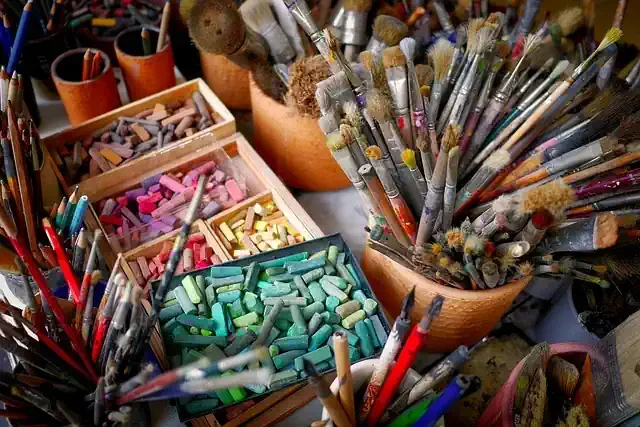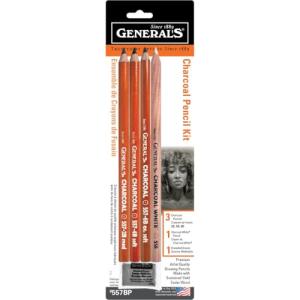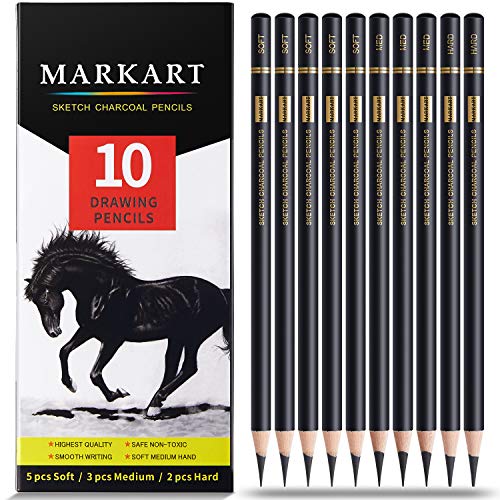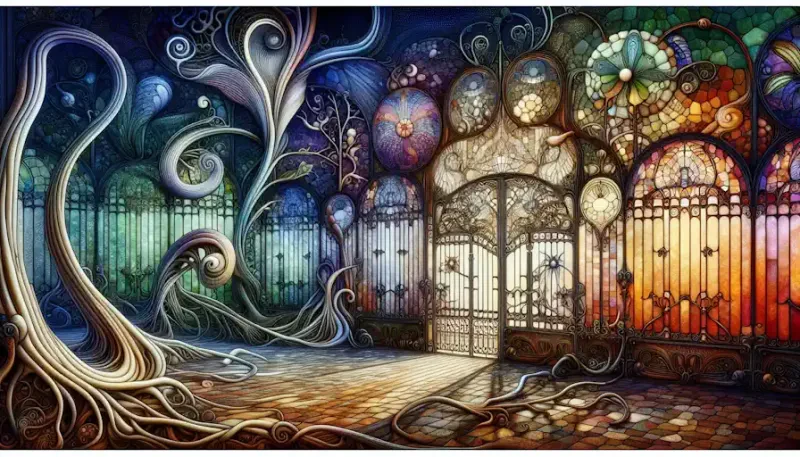A Guide To Choosing The Right Art Supplies
The world of art supplies is a vibrant and captivating one, overflowing with an astonishing array of tools and materials. From the humble pencil to the sophisticated digital drawing tablet, the sheer number of options can be overwhelming, especially for aspiring artists taking their first steps on their creative journeys. But fear not! This guide will serve as your compass, navigating you through the vast landscape of art supplies and helping you select the perfect tools to bring your artistic vision to life.
Considering Your Artistic Discipline
The very first step in choosing your art supplies is understanding the artistic discipline you wish to explore. Each artistic medium has its unique characteristics, strengths, and learning curve. Here's a closer look at some of the most popular disciplines and the art supplies that pair best with them:
Painting: A world of vibrant colors awaits aspiring painters. Popular mediums include acrylics, known for their fast drying times and versatility; oils, revered for their rich textures and smooth blending; watercolors, beloved for their delicate transparency and washes; and gouaches, offering the vibrancy of acrylics with the watercolor-like ability to be re-wetted.
Drawing: For artists who prefer the intimacy of line and form, drawing offers a multitude of possibilities. Pencils, the undisputed workhorses of drawing, come in a vast range of graphite hardness, allowing for everything from delicate sketching to bold shading. Charcoal, with its velvety texture, creates dramatic and expressive marks. Conte crayons, similar to pastels, offer a wider range of colors and blend beautifully. Finally, inks, both waterproof and water-soluble, provide a permanent and fluid drawing experience.
Sculpture: The world of sculpture is a realm of three-dimensional expression. Sculptors have a wide array of materials at their disposal, each offering unique challenges and possibilities. Clay, the most versatile sculpting material, comes in various types, from air-drying to kiln-fired. Wood, with its natural beauty and warmth, allows for detailed carving and intricate forms. Metal, for the more adventurous sculptor, offers strength and a unique aesthetic. Stone, a timeless choice, presents a challenge for beginners but rewards them with enduring and awe-inspiring creations. Even found objects, like discarded materials and natural treasures, can be transformed into captivating sculptures.
Planning Your Project
Before diving headfirst into acquiring art supplies, take a moment to consider the specific project you have in mind. Understanding the project's scope and requirements will guide you in selecting the most suitable tools and materials. Here are some key factors to ponder:
Size and Scale: Will your artwork be a miniature masterpiece or a sprawling mural that commands attention? Knowing the scale of your project is crucial. A small sketchbook might be sufficient for a detailed pen-and-ink drawing, while a large canvas is a better choice for a landscape painting bursting with vibrant colors.
Level of Detail: The level of detail you desire in your artwork will influence your choice of supplies. Do you envision a meticulously rendered portrait capturing every wrinkle and crease? Or are you aiming for a looser, more expressive style that conveys the essence of your subject? For highly detailed work, fine-tipped pens and brushes are ideal. Conversely, looser styles might be better achieved with soft pastels or broad strokes of a wide brush.
Subject Matter: The subject matter you choose can also play a role in selecting your art supplies. Are you drawn to capturing the lifelike details of a still life or a portrait? Or do you yearn to express abstract concepts and emotions through color and form? Realistic subjects often benefit from a wider range of colors and detailed brushes, while abstract art might thrive with a more limited color palette and bolder application techniques.
Honesty About Your Skill Level
There's no shame in being a beginner! In fact, it's the most exciting part of the artistic journey. Choosing the right art supplies for your skill level ensures you have the tools you need to learn, experiment, and grow as an artist. Here's a breakdown of how your skill level can influence your art supply choices:
Beginner: As a budding artist, it's wise to start with a core set of student-grade supplies. These are typically more affordable, allowing you to experiment with different techniques and mediums without breaking the bank. For drawing, a basic set of pencils with varying hardness levels, an eraser, and a sketchbook are all you need to get started. For painting, a starter acrylic paint set, some inexpensive brushes, and a canvas pad provide a great foundation for exploration.
Intermediate: As your skills develop and your confidence grows, you can gradually invest in better-quality materials. Intermediate artists might benefit from artist-grade pencils offering smoother graphite and more responsive blending. Upgrading to a few high-quality brushes in different shapes and sizes allows for greater control and finer detail in your paintings. Investing in a good quality canvas or watercolor paper can also significantly improve the look and feel of your artwork.
Advanced: Experienced artists understand the importance of professional-grade art supplies. These top-tier materials offer superior performance and longevity. Advanced artists might utilize a wider range of drawing pencils, including specialty grades for specific effects. Professional-grade brushes boast superior craftsmanship, allowing for exceptional control and precise application of paint. Investing in archival-quality materials, such as acid-free paper and lightfast paints, ensures your artwork stands the test of time and retains its vibrancy for years to come.
Quality Over Quantity: Why Investing in Better Supplies Makes a Difference
The allure of a vast array of colorful paints and fancy brushes is undeniable, but when it comes to art supplies, quality truly trumps quantity. While a beginner might be tempted by a massive set of student-grade supplies, investing in a few well-chosen, higher-quality materials can significantly enhance your artistic experience and the outcome of your artwork. Here's why prioritizing quality matters:
The Value of Quality Pigments: The heart and soul of any paint medium lies in its pigments. Student-grade paints often utilize cheaper, less lightfast pigments that can appear dull and fade over time. Conversely, professional-grade paints boast richly pigmented colors that are formulated with high-quality ingredients. These vibrant pigments translate to deeper, more accurate color representation and exceptional longevity, ensuring your artwork remains as stunning decades from now as it is the day you create it.
Improved Handling: The right tools can make all the difference in your artistic journey. Student-grade brushes, while seemingly affordable, can be frustrating to use. Their bristles might be coarse and lack the necessary spring, making it difficult to achieve smooth strokes and precise control. Investing in well-made, artist-grade brushes is a game-changer. These brushes are crafted with finer, more responsive bristles that hold their shape beautifully, allowing for effortless blending, detailed lines, and a truly enjoyable painting experience.
Archival Quality: For artists who desire their creations to stand the test of time, archival quality is paramount. Student-grade papers and canvases are often made with acidic materials that can cause your artwork to deteriorate and yellow over time. On the other hand, archival-quality papers and canvases are specifically designed for longevity. They are acid-free and treated to resist fading and discoloration, ensuring your artwork retains its vibrancy for generations to come. This is especially crucial for artists who plan to sell their work, exhibit it in galleries, or simply want to preserve their creations as cherished keepsakes.
Brand Recognition: A Guiding Light in the Art Supply Aisle
Navigating the vast sea of art supply brands can feel overwhelming. With countless manufacturers vying for your attention, it's natural to wonder which brands offer the best quality and value. Here's how brand recognition can be a guiding light in your art supply selection process:
Established Brands: Reputable art supply brands have built their reputations on consistent quality and reliable performance. These brands often have a long history of innovation and a dedication to providing artists with the tools they need to create exceptional work. They rigorously test their products and ensure they meet high quality standards. Choosing established brands is a safe bet, knowing you're getting reliable materials that will deliver the desired results.
Researching Online Reviews: The internet provides a wealth of information, and online reviews can be a valuable resource for artists seeking the perfect supplies. By reading reviews from fellow artists, you can gain valuable insights into the performance of specific products from different brands. Reviews can highlight the strengths and weaknesses of various art supplies, allowing you to make informed decisions based on the experiences of others with similar skill levels and artistic preferences.
Experimenting with Different Brands: While established brands and online reviews offer valuable guidance, there's no substitute for personal experience. Ultimately, the best way to discover which brands resonate most with you is to experiment with different products. Start with a few basic items from various brands within your budget and see how they feel in your hands. Observe how the paints blend, how the pencils draw, and how the brushes respond to your touch. Developing a personal connection with your art supplies can significantly enhance your creative process and artistic expression.
The Right Surface Makes a Difference: Choosing the Perfect Foundation for Your Artwork
The foundation you choose for your artwork plays a crucial role in the final outcome. Just as a skilled architect needs a sturdy base for a magnificent building, so too does an artist require the right surface to bring their vision to life. Here's a breakdown of how the choice of surface can impact different artistic disciplines:
Painting: For aspiring painters, the selection of canvas, paper, or panel is paramount. Canvas is the traditional choice for oil and acrylic paintings, offering a textured surface that allows for thick application of paint and a variety of brushstrokes. Watercolor paper is specifically designed to absorb watercolors effectively and allows for beautiful washes and layering techniques. Panels made of wood or other materials offer a smooth surface ideal for detailed acrylic paintings or mixed media creations.
Drawing: The quality of paper significantly impacts the look and feel of your drawings. Smooth paper allows for fine details and precise lines, making it ideal for technical drawings and pen-and-ink illustrations. Textured paper provides a unique surface for drawing, offering a more tactile experience and enhancing the effects of charcoal and conte crayons. Sketchbooks are a portable option for drawing on the go, perfect for capturing quick ideas and observations.
Sculpture: The base or armature that supports your sculpture is crucial for its stability and overall form. Wire armatures offer a flexible framework for creating three-dimensional structures. Wooden bases provide a sturdy foundation for heavier sculptures made from clay, metal, or stone. Found objects themselves can sometimes serve as the base for a sculpture, adding a unique element to the artwork.
Basic Tools: Your Essential Starters Kit
Every artistic journey begins with a foundational set of tools. Whether you're drawn to the intimacy of drawing, the vibrant world of painting, or the three-dimensional realm of sculpture, having the essential supplies on hand empowers you to translate your vision into reality. Here's a breakdown of the basic tools you'll need to kickstart your artistic adventure:
Drawing:
Pencils: The cornerstone of drawing, pencils come in a range of graphite hardness (HB, 2B, 6B, etc.). A starter set with a variety of hardness levels allows for exploration of light sketching, bold shading, and creating different textures.
Eraser: A good eraser is essential for correcting mistakes and creating highlights in your drawings. Kneaded erasers are popular for picking up unwanted pencil marks without damaging the paper.
Sharpener: Keeping your pencils sharp ensures clean lines and precise details. A manual or electric sharpener can be chosen based on your preference.
Drawing Paper: The paper you choose significantly impacts the look and feel of your drawings. For beginners, a smooth, medium-weight drawing paper is a versatile option.
Blending Stump (Optional): A blending stump, made of compressed paper or tortillon (rolled paper), allows for smooth blending of pencil marks and creating soft transitions.
Painting:
Brushes: The key players in painting, brushes come in various shapes and sizes, each suited for different techniques. A starter set with a few basic brushes, like a round brush for details, a flat brush for larger areas, and a filbert brush for blending, provides a good foundation.
Paints: The choice of paint depends on your preferred medium. Acrylics, known for their fast drying time and versatility, are a popular option for beginners. Watercolors offer a transparent and luminous quality, while oils provide rich colors and smooth blending.
Palette: A palette serves as a platform for mixing your paints. A simple plastic or wooden palette is sufficient for beginners.
Painting Surface: Depending on your chosen medium, you'll need a suitable surface. Canvas is ideal for acrylics and oils, while watercolor paper is specifically designed for watercolors.
Containers for Water (if using water-based paints): A cup or jar filled with clean water is essential for thinning water-based paints, cleaning your brushes, and creating washes with watercolors.
Sculpture:
Sculpting Tools (Material Dependent): The specific tools needed for sculpting vary depending on the chosen material. For clay sculpting, basic tools like sculpting knives, loop tools, and ribs allow for shaping, adding details, and creating textures. Metal sculpting might require specialized tools like hammers, chisels, and pliers.
Safety Gear (Optional, but Recommended): Depending on the sculpting material, safety gear like gloves, masks, and eye protection might be necessary to protect yourself from dust, fumes, or sharp edges.
Embrace the Thrill of Experimentation: Stepping Outside Your Comfort Zone
The path to artistic growth is paved with exploration and a willingness to experiment. While having a core set of tools is essential, don't be afraid to step outside your comfort zone and delve into new artistic territories. Here's how embracing experimentation can enhance your creative journey:
Stepping Outside Your Comfort Zone: As an artist, it's easy to get comfortable with your preferred techniques and materials. However, pushing your boundaries and trying new mediums can spark unexpected creativity and open doors to exciting artistic possibilities. If you're a seasoned drawer, consider exploring acrylic washes or working with oil pastels. A sculptor might find inspiration in experimenting with mixed media, incorporating found objects or scraps of fabric into their creations. Embracing the unknown can lead to artistic breakthroughs and the discovery of hidden talents.
Mixing and Matching Techniques: The beauty of art lies in its boundless possibilities. Don't feel confined to the traditional boundaries of a single medium. Explore the potential of combining drawing and painting, creating mixed media masterpieces that incorporate collage elements or unconventional materials. Watercolor washes can be beautifully layered with pen and ink illustrations, while acrylic paints can be used alongside charcoal to create dramatic effects. Experimentation allows you to develop a unique artistic voice and forge your own creative path.
Learning from Happy Accidents: The road to artistic mastery is rarely a straight line. Mistakes and unexpected outcomes are inevitable, but they can also be valuable learning experiences. Embrace "happy accidents" – those unforeseen occurrences that lead to surprising and beautiful results. A watercolor wash that bleeds unexpectedly can create a captivating effect, or a dropped brushstroke might spark a new compositional idea. Learning to see the potential in mistakes fosters a spirit of creative exploration and allows you to develop greater adaptability and problem-solving skills as an artist.
Building Your Art Supply Arsenal: A Sustainable Approach
As you delve deeper into your artistic endeavors, your collection of art supplies will naturally grow. But remember, quality trumps quantity. Here's how to strategically build your art supply arsenal for a fulfilling and sustainable creative journey:
Starting with a Core Set: Resist the urge to overwhelm yourself with a vast array of supplies. Begin with a well-chosen core set of essential tools tailored to your chosen discipline (refer to Section 8: Basic Tools: Your Essential Starters Kit for a breakdown). This foundation allows you to practice, develop your skills, and discover your artistic preferences before expanding your collection.
Savvy Shopping with Sales and Coupons: Building an art supply collection doesn't have to break the bank. Keep an eye out for sales and promotions at your local art supply store or online retailers. Many stores offer student discounts or loyalty programs that can help you stretch your budget further. Consider subscribing to email lists or following art supply stores on social media to stay informed about upcoming sales and special offers.
Pre-Made Art Sets: A Convenient Option: Pre-made art sets can be a convenient and cost-effective way to acquire a variety of basic supplies in a single purchase. These sets often include an assortment of pencils, brushes, paints, or sculpting tools, providing you with a well-rounded foundation to explore your artistic interests. Look for sets that align with your chosen medium and skill level to ensure you get the most out of your investment.
Investing in Quality Over Quantity: While student-grade supplies might be tempting initially, consider the long-term benefits of investing in higher-quality materials as your skills progress (refer to Section 5: Quality Over Quantity: Why Investing in Better Supplies Makes a Difference for a detailed explanation). Professional-grade tools offer superior performance and longevity, allowing you to create artwork that will stand the test of time. Upgrading your supplies gradually, based on your evolving needs, ensures you get the most value out of your investment.
Embrace Multi-functionality: When considering new art supplies, look for tools that offer versatility. A set of watercolor paints can be used for washes and detailed illustrations. Micron pens, known for their precise lines, can be equally effective for technical drawings and expressive sketches. Choosing multi-functional supplies allows you to explore a wider range of artistic techniques without needing a vast collection of specialized tools.
The Importance of Care and Maintenance: Taking good care of your art supplies extends their lifespan and ensures they continue to perform optimally. Clean your brushes regularly, store your paints properly, and sharpen your pencils as needed. Following these simple practices allows you to get the most out of your investment and reduces the need for frequent replacements.
By following these tips, you can build a well-curated art supply collection that supports your artistic growth without exceeding your budget. Remember, the most important tool in any artist's arsenal is their creativity. With dedication, exploration, and the right supplies at your fingertips, you're well on your way to embarking on a rewarding and fulfilling artistic journey.
Fostering Creativity: Cultivating an Inspiring Artistic Environment
The space you create for your art has a profound impact on your artistic process. A designated creative zone, free from distractions and brimming with inspiration, can ignite your imagination and fuel your artistic endeavors. Here's how to cultivate an inspiring artistic environment:
Finding Your Creative Haven: Dedicate a space in your home, no matter how big or small, to serve as your art studio. This dedicated space can be a room, a corner of a room, or even a portable art box for on-the-go creativity. The key is to ensure it's a place where you feel comfortable letting loose and expressing yourself freely.
Organization is Key: Maintaining a well-organized art space is essential for fostering a sense of calm and focus. Invest in storage solutions like shelves, bins, or drawers to keep your art supplies neatly organized and readily accessible. A designated area for your current project helps prevent clutter and allows you to pick up right where you left off.
Light the Way: Proper lighting is crucial for artistic endeavors. Natural light is ideal, so if possible, position your workspace near a window. Task lighting, such as an adjustable desk lamp, provides focused illumination for detailed work. Experiment with different lighting options to find what works best for you and the specific art form you're practicing.
Inspiration All Around: Surround yourself with things that inspire you creatively. Showcase artwork you admire, pin up inspirational quotes or photographs, or display personal collections that spark your imagination. Having these visual references readily available can ignite new ideas and keep you motivated throughout your artistic journey.
A Feast for the Senses: Art is a multi-sensory experience. Play music that sets the mood for creativity, light a scented candle to create a calming atmosphere, or keep a cup of tea or your favorite beverage on hand to fuel your artistic marathon. Curating an environment that engages multiple senses can enhance your focus and make the creative process even more enjoyable.
A Space for Exploration: Your art space should be a safe haven for experimentation and exploration. Don't be afraid to make mistakes, embrace the unexpected, and let your creativity flow freely. Having a dedicated zone free from judgment allows you to take risks, develop your artistic voice, and discover what truly inspires you.
By cultivating an inspiring artistic environment, you create a space that nurtures your creativity and empowers you to translate your vision into reality. So go forth, create your haven, and let your artistic journey flourish!
Beyond the Basics: Resources to Fuel Your Artistic Inspiration
The world of art is vast and ever-evolving, offering a never-ending source of inspiration and learning opportunities. As you embark on your artistic adventure, here are some resources to keep you fueled, informed, and inspired:
Art Museums and Galleries: Immerse yourself in the beauty and mastery of historical and contemporary art by visiting museums and galleries. Surround yourself with original works of art, observe different techniques and styles, and allow yourself to be inspired by the creative genius of others.
Art Books and Magazines: Art publications offer a wealth of information and inspiration. Books can provide in-depth explorations of specific artistic movements, techniques, or renowned artists. Art magazines often showcase contemporary artists, upcoming exhibitions, and practical tips and tricks to elevate your skills.
Online Resources: The internet is a treasure trove of artistic resources. Educational websites and online tutorials offer step-by-step guides for mastering various techniques. Art blogs and communities provide a platform for connecting with other artists, sharing your work, and gaining valuable feedback. Consider subscribing to online art courses or workshops for a more structured learning experience.
Life Drawing Classes: Sharpen your observational skills and learn to capture the essence of form by enrolling in a life drawing class. These classes provide a structured environment for practicing figure drawing with a live model, offering invaluable insights into anatomy, proportion, and light and shadow.
Workshops and Artist Residencies: Challenge yourself and deepen your artistic practice by attending workshops or artist residencies. Workshops offer intensive learning experiences under the guidance of experienced artists, while residencies provide dedicated time and space for focused artistic exploration.
Nature's Canvas: The natural world is a constant source of inspiration for artists. Step outdoors, sketch a landscape, capture the intricate details of a flower, or simply observe the play of light and shadow on your surroundings. Nature's beauty offers endless possibilities for artistic exploration.
By actively seeking out these resources, you'll keep the fire of your creativity burning brightly. Remember, the journey of an artist is a lifelong exploration. Embrace the opportunity to learn, grow, and find inspiration in everything that surrounds you.
Conclusion: The Journey Begins Here
The world of art awaits you, brimming with vibrant colors, captivating textures, and endless possibilities for creative expression. This guide has equipped you with the knowledge to navigate the vast landscape of art supplies, cultivate an inspiring creative space, and discover resources to fuel your artistic journey.
Remember, there's no single right way to make art. Embrace the process, experiment with different techniques, and most importantly, have fun! Let your imagination soar, unleash your creativity, and allow your artistic voice to blossom. The only limit is your own artistic vision.
So, pick up your pencils, brushes, or sculpting tools, and embark on this exciting adventure. Every masterpiece begins with a single mark, and every artist's journey starts with a single step. Take that step today and witness the magic that unfolds on your creative canvas.







